Jamie Carstairs (Senior Digitisation Officer, Special Collections, University of Bristol Library) is researching the work of Charles Frederick Moore (1838-1916), and here discusses Moore’s photographs of the ruins of the European-style, baroque palaces at the Yuanmingyuan.
When the vast and magnificent Yuanmingyuan (The Garden of Perfect Brightness; or ‘Old Summer Palace’) garden-palace, eight kilometres (five miles) northwest of the Forbidden City, Beijing, was plundered and burnt down by vengeful Anglo-French forces in October 1860, hundreds of wooden Chinese buildings were destroyed. Still standing however, were the burnt-out ruins of the Emperor’s European-style brick and stone palaces (Xiyanglou), built in the latter half of the Eighteenth century. The Xiyanglou occupied about two per cent of the Yuanmingyuan site. These palaces reportedly presented an extraordinary feast for the eye – a fairyland of rococo architectural flourishes, glazed ceramic decorations in sublime colours, elaborate splashy fountains, reflective pools, roof tiles in rainbow tints, and theatrical perspective vistas, along with horticultural special effects and birdsong (1).
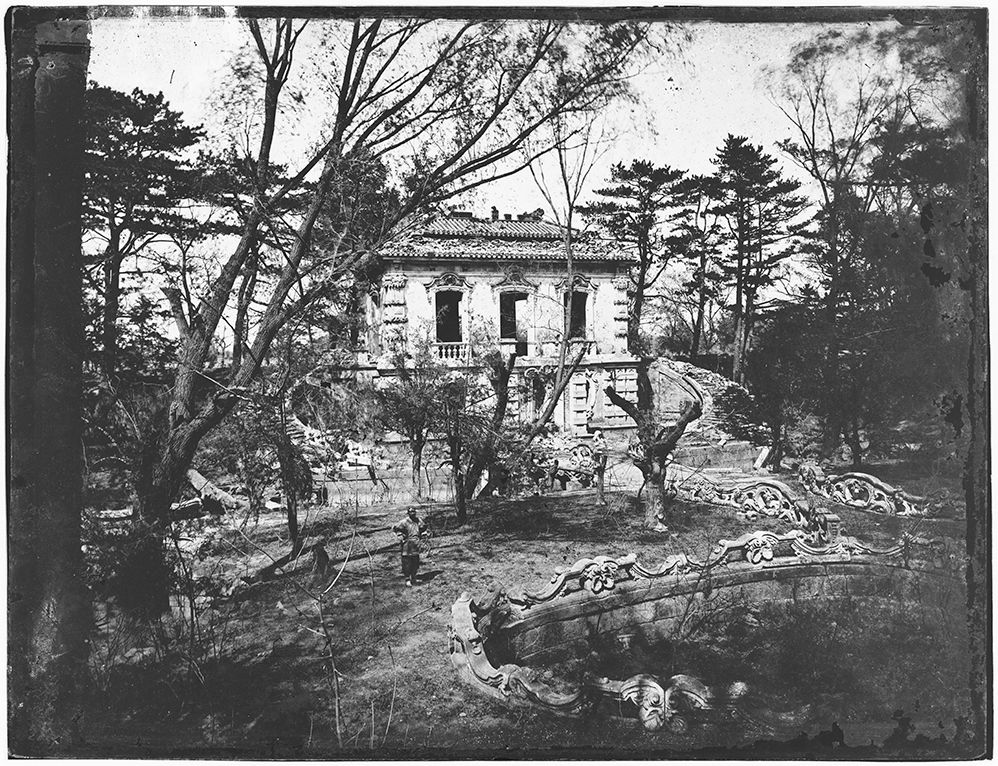
Fig. 1: The Fangwaiguan (the ‘Look Abroad Hall’ or ‘Belvedere’), showing flamboyant marble balustrades and bridges, and its Chinese-style roof. A man waits for the photographer to take the picture, with his hands on his hips. The Fangwaiguan was the only large building at the Xiyanglou which survived the burning with its roof intact. Photograph by C.F. Moore. Royal BC Museum, ref J-00443.

Fig. 2: West meets east. The Xiyanglou was planned and designed by the Italian Guiseppe Castiglione S.J. and can be seen as a triumph of Sino-European interaction. In this detail/extract of C.F. Moore’s photograph of the ‘Clock Gate’, near the Xieqiqu, one side of the structure is rococo, while the other side facing into another imperial garden at the Yuanmingyuan, is in a traditional Chinese architectural style. Royal BC Museum, ref J-00463.
After the 1860 disaster (2), and some repair work, the ruins of the Xiyanglou were generally abandoned to the elements and to thieves, who repurposed the building materials, stealing also timber and valuable metals – lead, iron and copper. Pilfering and further destruction set in after repair work ceased and plans for the restoration of the Yuanmingyuan were shelved, in 1874. Eventually the ruins of the Xiyanglou were reduced to the pitiful (and politically manipulated) piles of rubble we see today.
Until the 1911 revolution, the garden-palace site officially remained an imperial preserve and access was not allowed, becoming fully out of bounds to visitors in about 1886 (3). Nevertheless, at least four foreign photographers entered the landscaped grounds during the 1870s and 1880s, and on several occasions. Charles Frederick Moore, among others, was deeply impressed, writing: ‘Here amid an expanse covering twelve square miles of ground, all the ingenious diversities and embellishments of Chinese architectural and horticultural art had been exhausted to produce a terrestrial paradise … This beautiful monument of Eastern art, the garden of perpetual brightness, is now a desolate ruin – in retaliation for the imprisonment and murder of many British prisoners’ (4).
The photographs of the European-style baroque palaces (Xiyanglou) by Ernst Ohlmer (5) and Thomas Child (6) are well documented; those by Moore have become known about in more recent times thanks to digitisation by Royal BC Museum archives (7).
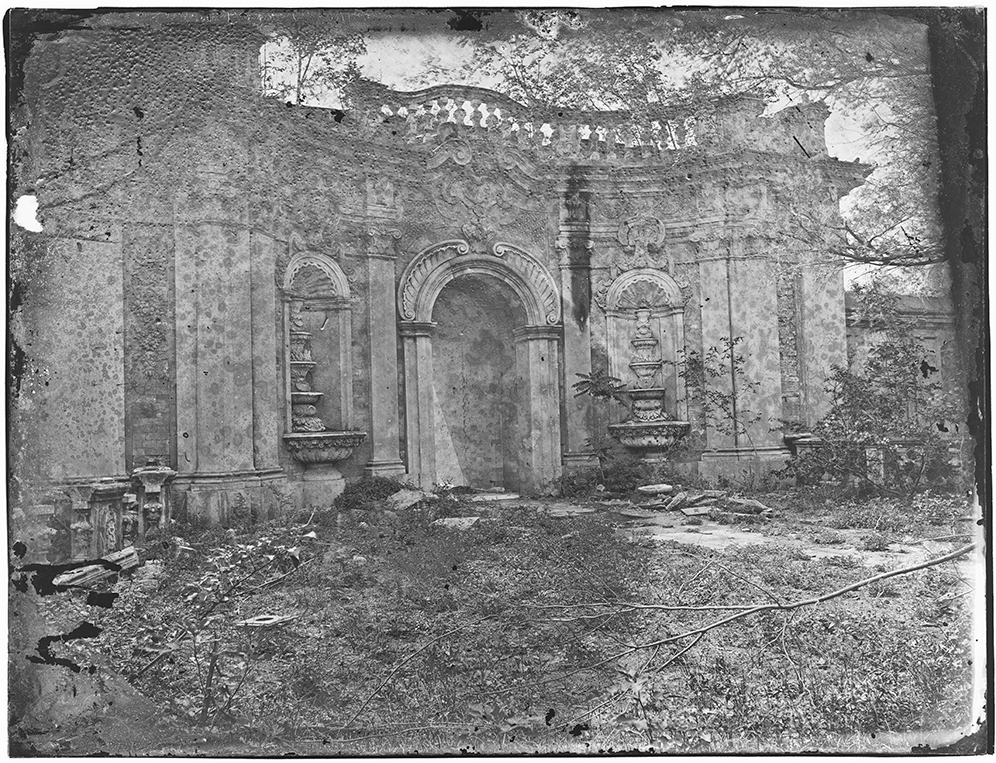
Fig. 3: The Yangquelong Dongmian (the Gate to the Aviary or the Fountain Gate) viewed from the east. This is a wider view than Thomas Child’s photograph (No. 204), and taken at a later date (a large section of balustrade is gone in Moore’s photograph), perhaps 1880. Royal BC Museum, ref J-00423.
The Royal BC Museum holds 99 glass plate negatives (MS-3171), and an album (MS3171-1), which were gifted to the museum by descendants of C.F. Moore, with related papers etc, in 2014. The provenance of this material previously owned by C.F. Moore’s family, is compelling, if not conclusive. Some of the images were reproduced in a pamphlet published twice in c.1905, entitled on the cover: A Quarter of a Century in China / Experiences of a Victorian in the Flowery Kingdom with ‘Chinese’ Gordon / CHINA ILLUSTRATED / By C.F. Moore, Paymaster in Green Turbans of Anglo Chinese Contingent / ALL RIGHTS RESERVED (8) – fig. 4. Several of the images in A Quarter of a Century in China were also reproduced in an eponymous article by Moore, published in the Victoria Daily Times, 8 April 1905 – fig. 5.
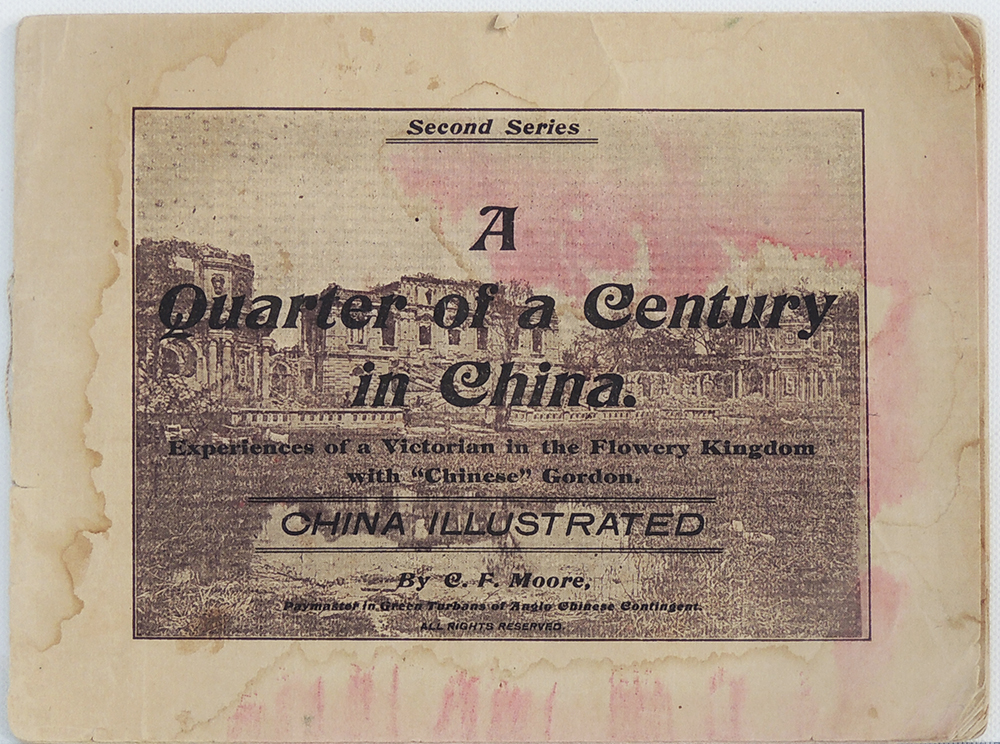
Fig. 4: The cover of A Quarter of a Century in China by C.F. Moore. The photograph shows part of the Music Pavilion in the west, the central three-storied part of the Xieqiqu (Palace of the Delights of Harmony), and the gallery curving around to the Music Pavilion at the east. Viewed from the south, across the weed choked pool/basin, reflecting the ruins of the palace. Two men are posed by the balustrade around the pool/basin. Ernst Ohlmer’s photograph of the south side of the Xieqiqu was taken before Moore’s; Thomas Child’s after. See footnote 1 for Ohlmer’s description of this palace.
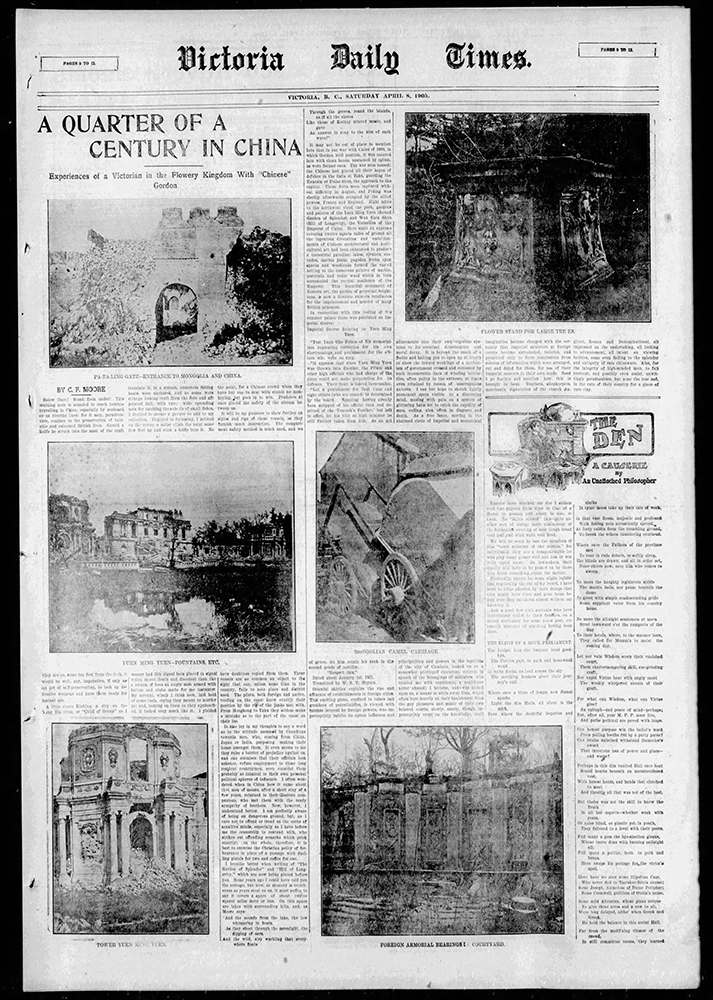
Fig. 5: ‘Victoria Daily Times’, 8 April 1905, page 9.
High-resolution scans of Moore’s negatives (available from Royal BC Museum archives) reward close study and constitute a significant visual resource. Of Moore’s 99 glass plate negatives which survive to this day, thirteen were taken at the Yuanmingyuan (twelve different views, refs: J-00464, J-00463, J-00423, J-00465, J-00443, J-00413, J-00508, J-00466, J-00479, J-00442, J-00426, J-00459, J-00444), complementing Ohlmer’s twelve extant glass plate negatives and the ten, or so, known photographs by Child.
Several photographic prints made from Moore’s negatives exist. In addition, there are currently eleven known photographs, as prints, depicting different views of the Yuanmingyuan by Moore (for which no negatives have survived it seems). A further six images by Moore exist only as reproductions, as far as is known just now, making a total of twenty-nine currently known different images of the Yuanmingyaun by Moore (9).
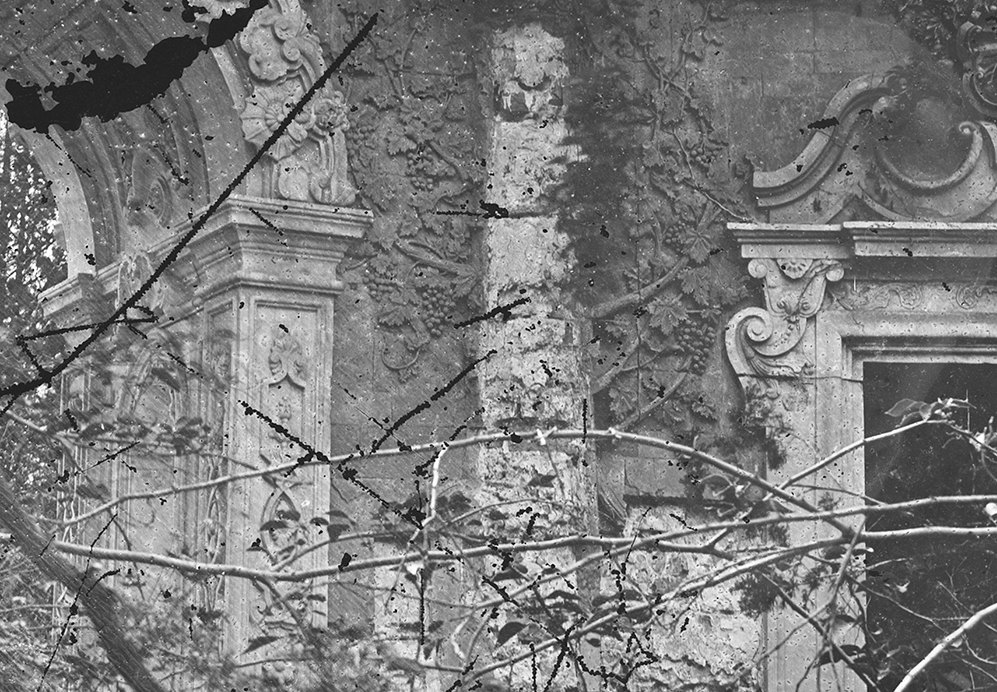
Fig. 6: A detail/extract of Moore’s photograph of Xianshan Dongmen (Gate east of the Hill of Perspective). This is an evocative photograph, which relates to the ‘pleasure of ruins’ – the luxuriant plants growing wild echoing the rococo vine carving on the gate. Xianshan Dongmen was not photographed by Child or Ohlmer. Royal BC Museum, ref J-00426.
Moore’s Yuanmingyuan work has previously been mistakenly attributed to Théophile Piry, or to Thomas Child, or to Ernst Ohlmer, or to anon – or not attributed at all. Régine Thiriez, in her excellent book Barbarian Lens (2017), tentatively attributed several Yuanmingyuan pictures to Piry. But in 1994, Thiriez had located some prints with indented round top corners, made with a mask placed on the photographic paper (rather than the photographic paper being cut to shape with scissors), which could, she wrote, be the work of ‘a new photographer’ (i.e. not by Piry, nor Ohlmer, nor Child) (10).
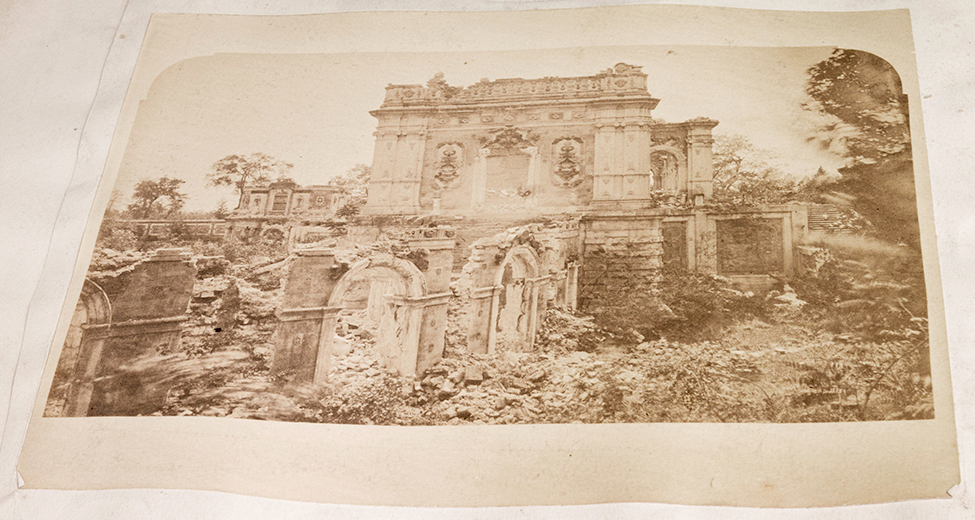
Fig. 7: An example of a print made with an indented round top corner printing mask. This print is in Moore’s album at the Royal BC Museum (ref MS-3171-1 page 68 of the pdf), an album page photographed at an angle. Compare this photograph with similar views of the Xieqiqu (Palace of the Delights of Harmony) by Ernst Ohlmer and Thomas Child.
It has turned out that a photograph made with an indented round top corner printing mask, indicates a photograph by Moore – he is thought to be the only Nineteenth century photographer in China who used such a mask, described by Thiriez as a ‘signature’ (see figs 7 and 8). Like other photographers, Moore also occasionally made prints with an oval/cameo shaped mask, as well as rectangular prints, and, much less often, cut prints to an oval shape. A further ‘signature’ or ‘tell’ noted in some of Moore’s photographs is his deliberate posing of strategically placed seated or standing men around the scene/composition (e.g. Bo01-044).
![Fig 8. The 'Palace of the Delights of Harmony' (Xieqiqu), Yuanmingyuan, viewed from the south, across the weed choked pool, reflecting the ruins of the palace. Two men are posed by the balustrade around the pool. This print was made with an indented rounded corner mask (i.e. a 'signature' of Moore's) and captioned: ‘Bâtiment principal construit par […] a Yuen Ming Yuen / Etat 1879 d'après Moore / 26 / 19’. This is a key photographic print/captioning, connecting Moore's name with the rounded corner mask, strategically placed people, as well as showing more from his (lost) negative than other prints. A well composed and frequently reproduced photograph, its punctum, for many, being the reflection of the ruin in the water. Source: Part of Lot 2, in an auction by Tessier & Sarrou et Associés, Paris, on 17 December 2018.](https://hpchina.blogs.bristol.ac.uk/files/2022/05/Annotation-2022-05-18-180749.jpg)
Fig 8. The ‘Palace of the Delights of Harmony’ (Xieqiqu), Yuanmingyuan, viewed from the south, across the weed choked pool, reflecting the ruins of the palace. Two men are posed by the balustrade around the pool. This print was made with an indented rounded corner mask (i.e. a ‘signature’ of Moore’s) and captioned: ‘Bâtiment principal construit par […] a Yuen Ming Yuen / Etat 1879 d’après Moore / 26 / 19’. This is a key photographic print/captioning, connecting Moore’s name with the rounded corner mask, strategically placed people, as well as showing more from his (lost) negative than other prints. A well composed and frequently reproduced photograph, its punctum, for many, being the reflection of the ruin in the water. Source: Part of Lot 2, in an auction by Tessier & Sarrou et Associés, Paris, on 17 December 2018.
Along with the twenty copperplate engravings made by the Manchu court artist Yi Lantai (Yilantai) in 1783 – 1786, some surviving plans, other engravings and drawings, the historical photographs by Ohlmer, Child and Moore provide the key visual record of the European-style palace complex before its destruction and degradation. The uses of these historical photographs are manifold, for example, the Xiyanglou Digital Restoration Project matched archaeological fragments to their original locations on buildings and provided insights into original colours despite the old photographs being monochrome (14).
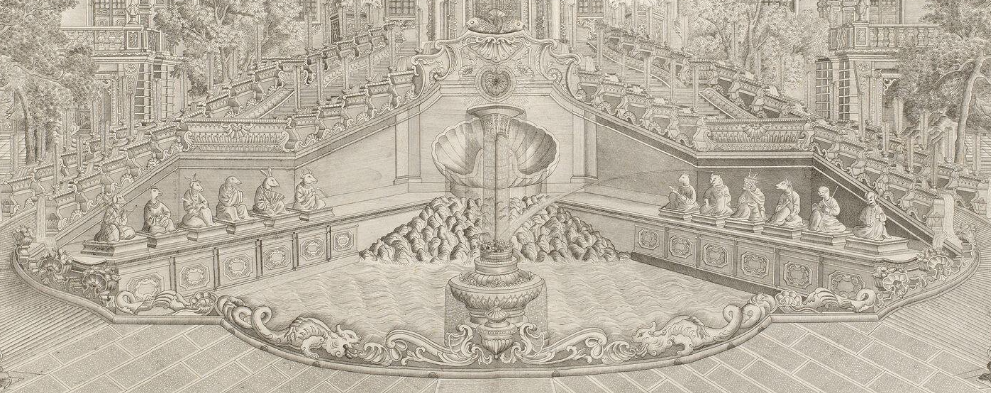
Fig. 9: Part of the copperplate engraving #10, of the Haiyantang (Palace of the Calm Seas) by Yi Lantai, 1783-86. The largest of the foreign buildings, with the most elaborate fountains, including the masterpiece of the French Jesuit, Michel Benoist S.J. – a water clock which featured twelve bronze, seated, zodiacal figures. The figure of the horse is spouting a stream of water. The hours of the horse are from 11am to 1pm. Other fountains playing on both sides of the pair of stairs.
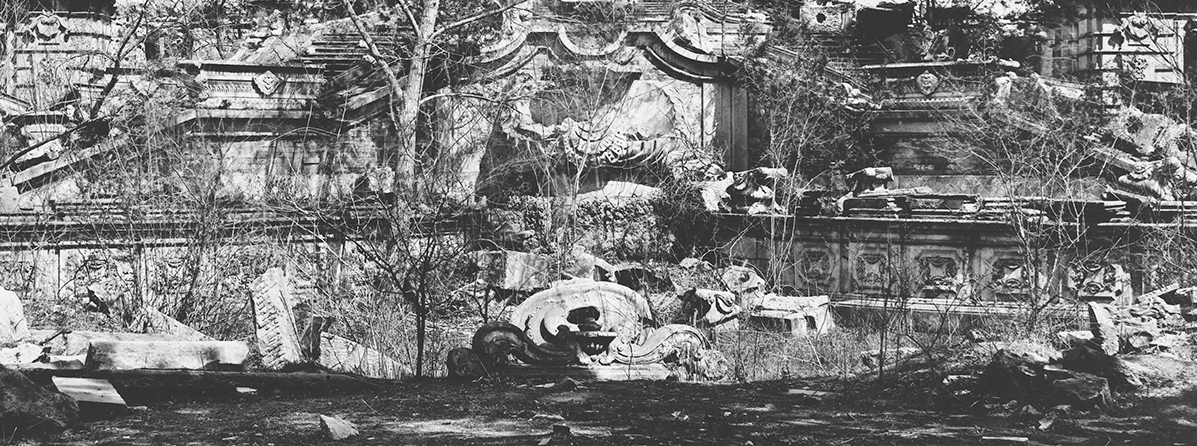
Fig. 10: A detail/extract of Moore’s photograph of the Haiyantang (Palace of the Calm Seas). Royal BC Museum, ref J-00413. The photographs of the Haiyantang by Moore and Ohlmer were both taken from a similar viewpoint – although Moore’s is a wider view. The foreground (clock fountain) is captured better in Moore’s photograph; the background (building) in Ohlmer’s is better.
I have started a detailed analysis of twenty-nine Yuanmingyuan photographs by Moore, locating the buildings, with thumbnail images, and noting previous attributions, etc. Taking a cue from Carroll Brown Malone and his ‘sketch plan of the foreign buildings’ (fig. 11 below), I have organised this analysis in fourteen coloured sections, with each section headed by one of Yi Lantai’s copperplate engravings. It is expected for sure, that in due course, more Moore’s will be discovered and that this list can be augmented. The spreadsheet analysis is available here [revised 17 December 2023].
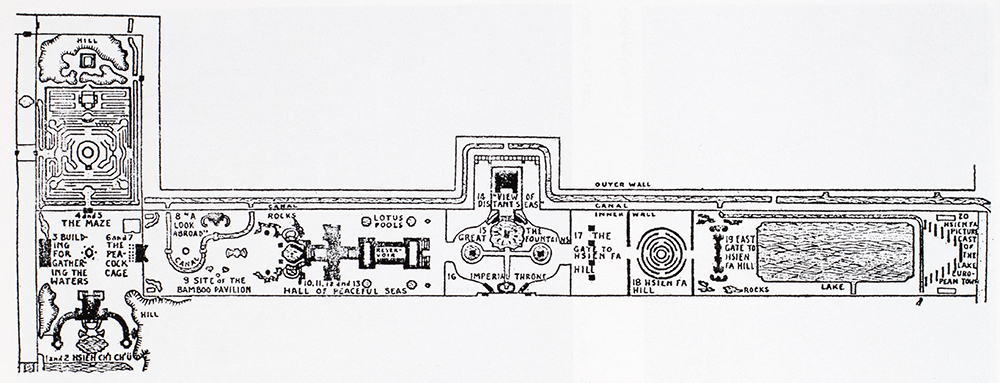
Fig. 11: A plan of the Xiyanglou (European-style palaces) from History of the Peking Summer Palaces under the Ch’ing Dynasty by Carroll Brown Malone (1934), as reproduced in La Chine entre le Collodion Humide et le Gelatinobromure by Bernard Marbot and René Viénet (1978).
Footnotes
- Ernst Ohlmer, who admired glazed ceramics and collected Ming and Qing dynasty porcelain, photographed the ruins of the European-style palaces in 1873, and described Xieqiqu (the Palace of the Delights of Harmony) in the following vivid and evocative and word picture: ‘The decoration […] had been given all the colours and nuances of the rainbow […] You see the rich and lively colours of the ornamentation, saturated by the deep blue Peking sky, kaleidoscopically changing according to the position of the viewer and of the sun, standing out boldly against the white marble background of the building, and at the same time being like a ghostly mirage reflected in the lake facing it […] The observer cannot help feeling like in a fairy-tale from A Thousand and One Nights.’ (Ernst Ohlmer, Führer Durch Die Ohlmer’sche Sammlung Chinesischer Porzellane: Z.Z. Aufgestellt Im Roemer-Museum Hildesheim. Mit 10 Tafeln und 3 Zinkographien Von E, Ohlmer (Hildesheim: Gerstenberg, 1898), p.32, cited in Régine Thiriez, Barbarian Lens, p. 92. Translated by A.W. Mixius).
- For an account about how the invaders came to the awful decision to burn the emperor’s extensive palace complex, see, for example, Young-Tsu Wong A Paradise Lost, The Imperial Garden at Yuanming Yuan and Robert Bickers, The Scramble for China: Foreign Devils in the Qing Empire, 1832-1914 (2011), pp. 149-50.
- Thiriez, Barbarian Lens, footnote 2 (for chapter 4), p. 164.
- Quotation from Charles Frederick Moore, A Quarter of a Century in China, Experiences of a Victorian in the Flowery Kingdom with ‘Chinese’ Gordon, p. 10. The description is also in C.F. Moore’s mss notebook (Royal BC Museum archive ref: MS-3171/5), being his magic lantern (‘stereoptican view’) slide show note for slide 50. Moore presented the slide show (entitled ‘Lecture on China in the Time of General Gordon’) more than once, including on 15 January 1907 at St Barnabas’ School Room, Victoria BC, Canada. A similar (draft?) description is on page 50 of the pdf of the Moore album (Royal BC Museum archive ref: MS-3171/1).
- Note the well reproduced images from Ohlmer’s negatives in: Beijing World Art Museum. Can Yuan Qin Meng: Aoermo Yu Yuanmingyuan Lishi Yingxiang. Disturbed Dreams in the Ruins of the Garden, Ernest Ohlmer and Historical Images of Yuanmingyuan. See Maureen Warren, Romanticizing the Uncanny: Ernst Ohlmer’s 1873 photographs of the European-style palaces in the Yuanmingyuan (2017). For thorough analysis of photographs of the Xiyanglou (taken between the 1870s and 1920s), see Régine Thiriez, Barbarian Lens.
- For example: Stacy Lambrow and Jacob Loewentheil, Thomas Child’s Photographs of Yuanmingyuan. See also Thiriez, Barbarian Lens.
- A brief biography of Charles Frederick Moore can be found here. For initial research into his life as a photographer in China, see my earlier post on this blog site: ‘Charles Frederick Moore (1837-1916), a photographer in China‘. A further eleven photographs taken at Yuanmingyuan in the 1870s by an (as yet) unidentified photographer, are reproduced in Terry Bennett’s History of Photography in China, Western Photographers 1861-1879, pp.300-302. More nineteenth century Yuanmingyuan photographs exist, here and there, including views by the French nobleman and diplomat, Robert de Semallé (1839-1946), taken in c.1882.
- ‘Victorian’ here means a resident of Victoria BC, Canada. The Toyo Bunko has a copy of this rare pamphlet, published in two editions, as ‘First Series’ and ‘Second Series’ (Toyo Bunko ref: P-III-a-53).
- A handful of Moore’s Yuanmingyuan photographs are particularly important, as they are the only Nineteenth Century photographic record of certain parts of the site.
- Thiriez, Barbarian Lens, footnotes 7 and 8 (for chapter 9), p. 167.
- Lambrow and Loewentheil, p. 156.
- Lambrow and Loewentheil, p. 156, footnote 16.
- Thiriez, p. 89.
- See Digital Restoration Research and Three-Dimensional Model Construction on Xieqiqu by Gao Ming, Piao Wenzi and Guo Jing.
Bibliography
Becker, Jasper. City of Heavenly Tranquility, Beijing in the History of China (2008).
Beijing World Art Museum. Can Yuan Qin Meng: Aoermo Yu Yuanmingyuan Lishi Yingxiang. Disturbed Dreams in the Ruins of the Garden, Ernest Ohlmer and Historical Images of Yuanmingyuan (2010).
Bennett, Terry. History of Photography in China, Western Photographers 1861-1879 (2010).
Bickers, Robert. The Scramble for China: Foreign Devils in the Qing Empire, 1832-1911 (2011).
Gao Ming, Piao Wenzi and Guo Jing Digital Restoration Research and Three-Dimensional Model Construction on Xieqiqu (2015).
Lambrow, Stacy and Jacob Loewentheil. Thomas Child’s Photographs of Yuanmingyuan (Collectors World, 2018).
Lee, Haiyan. The Ruins of Yuanmingyuan: Or, How to Enjoy a National Wound (2009).
Malone, Carroll Brown. History of the Peking Summer Palaces under the Ch’ing Dynasty (1934).
Marbot, Bernard and René Viénet. La Chine entre le Collodion Humide et le Gelatinobromure (1978).
Moore, Charles Frederick. A Quarter of a Century in China, Experiences of a Victorian in the Flowery Kingdom with ‘Chinese’ Gordon (c.1905).
Thiriez, Régine. Barbarian Lens, Western Photographers of the Qianlong Emperor’s European Palaces (2017).
Wong, Young-Tsu. A Paradise Lost, the Imperial Garden at Yuanming Yuan (2021).
